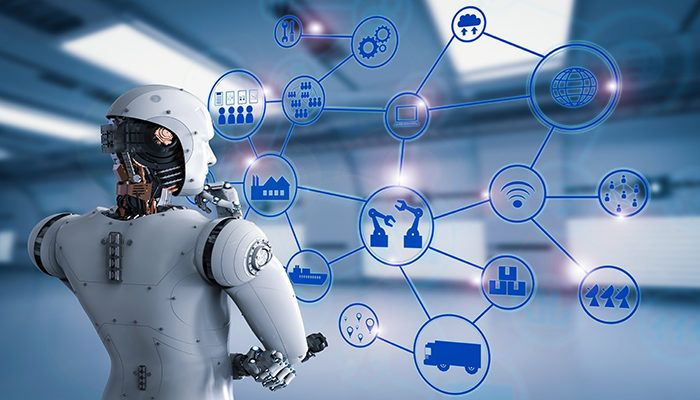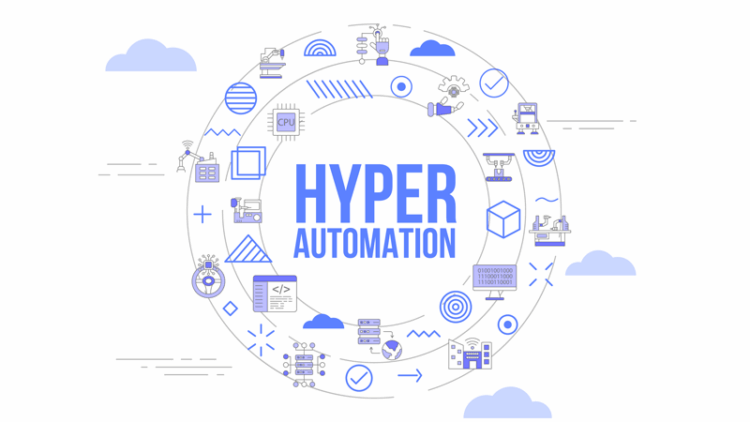Unleash Growth: Why Hyperautomation Software Now?
In the current hyper-competitive business landscape, achieving operational excellence is no longer just an advantage it’s a survival imperative. Enterprises globally are navigating unprecedented complexity, from volatile supply chains and evolving customer expectations to the constant pressure for digital transformation. This environment necessitates a fundamental shift from simple task-based automation to a comprehensive, intelligence-driven strategy. This is where Hyperautomation Software steps in, representing the next frontier in organizational efficiency and strategic agility.
Hyperautomation is more than just a buzzword; it’s a disciplined, business-driven approach that involves the orchestrated use of multiple advanced technologies, tools, and platforms to rapidly identify, vet, and automate as many business and IT processes as possible. It is a monumental step beyond traditional Robotic Process Automation (RPA), combining it with powerful cognitive capabilities like Artificial Intelligence (AI) and Machine Learning (ML) to automate end-to-end workflows that involve unstructured data and complex decision-making.
If your organization hasn’t fully committed to a hyperautomation strategy, you are not simply missing out on incremental efficiency gains; you are ceding the future of your market to competitors who are embracing this transformative technology. The time to implement hyperautomation software is unequivocally now.
Defining the Hyperautomation Revolution
To appreciate why this technology is so crucial right now, one must first understand what it is and how it differs from its predecessors.
A. Moving Beyond Traditional Automation
Historically, automation efforts relied heavily on Robotic Process Automation (RPA). RPA is superb for automating high-volume, repetitive, rule-based tasks (like data entry or generating simple reports) within a user interface, mimicking human actions. However, RPA hits a wall when processes involve:
- Unstructured Data: Documents, emails, images, and other non-standardized formats.
- Complex Decisions: Tasks requiring human-like judgment, predictive analysis, or learning from outcomes.
- Fragmented Systems: Workflows that span multiple, disparate legacy systems and modern cloud applications.
Hyperautomation demolishes this wall by integrating RPA with a suite of sophisticated technologies, creating an Intelligent Digital Workforce.
B. The Core Technology Stack
Hyperautomation is an ecosystem of integrated technologies designed for comprehensive, scaled automation. The key components include:
A. Robotic Process Automation (RPA): The foundational “digital hands” that interact with applications and systems.
B. Artificial Intelligence (AI) and Machine Learning (ML): The “digital brain” that provides cognitive capabilities, enabling decision-making, data analysis, and predictive insights.
C. Intelligent Document Processing (IDP): Tools using AI/ML (like Optical Character Recognition and Natural Language Processing) to extract and process data from unstructured documents (invoices, forms, contracts).
D. Process Mining and Task Mining: Discovery tools used to analyze event logs and user interactions to automatically map, visualize, and identify the most valuable and high-impact processes ripe for automation.
E. Low-Code/No-Code (LCNC) Platforms: Tools that empower “citizen developers”—business users without deep coding knowledge—to design, build, and deploy automated workflows rapidly.
F. Integration Platform as a Service (iPaaS): The crucial glue that seamlessly connects disparate cloud and on-premise applications, allowing data and processes to flow effortlessly across the enterprise.
This unified approach allows organizations to automate nearly any process, from the most mundane to the most complex and mission-critical.
The Critical Urgency for Implementation
The immediate need for hyperautomation is driven by significant shifts in the global business environment. Delaying adoption means falling behind in core areas of competitive advantage.
A. Necessity for Extreme Operational Efficiency
In an era defined by tight margins and resource constraints, efficiency is king. Hyperautomation offers gains far beyond simple cost reduction.
- Maximum Throughput, Minimal Error: Automated systems can operate 24/7/365, handling massive volumes of data and transactions with near-perfect accuracy, which is simply unachievable with manual labor. This directly impacts core processes like invoice processing, claims management, and customer service.
- Scalability on Demand: Business volume often fluctuates unexpectedly. Hyperautomation allows enterprises to instantly scale their digital workforce up or down to meet demand peaks (e.g., holiday seasons, regulatory reporting cycles) without the overhead and lead time required for hiring and training human staff.
B. The Need for True Business Agility
Market conditions, customer trends, and regulations change at an accelerating pace. Businesses must be able to pivot quickly.
A. Rapid Process Redesign: Traditional business process changes can take months or years. By leveraging LCNC platforms and process mining, hyperautomation allows organizations to quickly identify bottlenecks, redesign workflows digitally, and deploy new automated processes in weeks or even days. B. Data-Driven Decision Making: The technology automatically collects and analyzes real-time data from every automated step. This flow of highly accurate, current data provides senior leaders with the Intelligent Insights necessary to make strategic decisions faster and with greater confidence.
C. The Empowerment of the Human Workforce
Contrary to fears of job replacement, hyperautomation is a powerful tool for workforce augmentation.
- Eliminating the Mundane: By offloading repetitive, soul-crushing tasks, hyperautomation frees human employees to focus on high-value, creative, complex, and strategic work that truly requires human intellect and empathy.
- Boosting Employee Engagement: Employees empowered to focus on meaningful work experience higher job satisfaction and engagement. Furthermore, LCNC tools empower business unit experts to solve their own operational problems, fostering an environment of innovation from the ground up the rise of the Citizen Developer.

Strategic Benefits of Hyperautomation Software
Adopting this advanced automation strategy yields substantial, multi-faceted benefits that directly translate into improved financial and market performance.
A. Financial Impact and Cost Optimization
The reduction in operational expenditure (OpEx) is often the first visible benefit.
- Lower Labor Costs: Automating tasks currently performed manually reduces the need for constant growth in headcount to meet volume increases.
- Reduced Rework: Near-perfect accuracy from automated processes minimizes costly human errors, such as incorrect data entry, misplaced files, or erroneous calculations in finance and compliance.
- Accelerated Cash Flow: Automation in finance processes, like accounts payable and accounts receivable, significantly speeds up invoice processing and payment cycles, improving working capital management.
B. Enhanced Customer and Employee Experience
The impact extends beyond the balance sheet to the people who interact with the business. A. Hyper-Personalized Service: AI-driven hyperautomation can analyze massive amounts of customer interaction data in real-time, allowing systems to deliver highly personalized and instantaneous service across all channels (omnichannel). For example, automated agents can handle Tier 1 support instantly, only escalating to a human agent when complexity demands it. B. Seamless Operations: By linking formerly siloed departments (e.g., Sales, Operations, Finance) through end-to-end automated workflows, the customer journey becomes smooth, quick, and consistent, leading to higher satisfaction and loyalty.
C. Compliance and Risk Mitigation
In heavily regulated industries, hyperautomation is an indispensable tool for governance and compliance.
- Automated Audit Trails: Every automated transaction creates a meticulous, time-stamped, and tamper-proof digital record. This simplifies audit preparation and ensures processes consistently adhere to regulatory mandates (e.g., GDPR, HIPAA).
- Proactive Security: Automation can be applied to cybersecurity response, where bots can instantly detect anomalies and automatically isolate threats or revoke access credentials far faster than any human security team, minimizing exposure to risk.
Real-World Applications Across Industries
Hyperautomation is a horizontal technology, meaning its benefits span every industry and business function.
A. Financial Services (BFSI)
Financial institutions are leveraging hyperautomation for: A. Loan Origination: Automating the collection, verification, and risk assessment of documents and customer data, reducing loan application turnaround time from days to minutes. B. Fraud Detection and AML Compliance: Using AI/ML to analyze transaction patterns in real-time, instantly flagging suspicious activity for human review and automating mandatory regulatory reporting.
B. Healthcare
The sector uses hyperautomation to improve patient care and reduce administrative burden. A. Patient Onboarding and Billing: Automating insurance eligibility checks, pre-authorizations, and complex billing cycles, which significantly reduces claim denial rates and administrative friction. B. Clinical Operations: Automating the scheduling of follow-up appointments, managing inventory for medical supplies, and ensuring the timely transfer of patient records between systems.
C. Supply Chain and Logistics
Hyperautomation optimizes the movement of goods and information globally. A. Inventory and Order Management: Real-time synchronization of inventory levels with e-commerce platforms and ERP systems, automatically triggering procurement orders based on predictive demand forecasting (AI-driven). B. Logistics Optimization: Using advanced analytics and machine learning to optimize delivery routes, manage warehouse robotic systems, and automate customs documentation generation.
D. Human Resources (HR)
Automating the “Hire-to-Retire” lifecycle frees HR staff for employee development and culture building.
A. Recruitment and Onboarding: Automated screening of resumes using NLP, scheduling interviews, and generating all necessary digital documentation (tax forms, contracts) for new hires.
B. Payroll and Benefits: Ensuring error-free, timely payroll processing and automatically managing employee life-cycle events (promotions, transfers, leaves of absence).
Preparing Your Organization for Hyperautomation
Successfully deploying hyperautomation is a strategic journey, not a singular project. It requires careful planning and a culture shift.
A. Strategic Roadmap and Governance
Do not attempt to automate everything at once. A disciplined approach is essential.
- Process Discovery First: Begin with Process Mining and Task Mining tools to objectively identify and prioritize the 5-10 processes that offer the highest return on investment (ROI) and feasibility for automation. Look for processes that are high-volume, repetitive, rule-based, and costly.
- Establish a Center of Excellence (CoE): Create a centralized team to define governance standards, manage security, maintain technology licenses, and foster best practices across the organization. This prevents ‘shadow automation’ and ensures scalability.
B. Overcoming Implementation Challenges
While the benefits are immense, the journey presents hurdles: A. Data Quality and Readiness: Automation relies on clean, accessible data. Poor quality data is the most common failure point. Investment in data cleansing and modern data integration solutions (iPaaS) is crucial. B. Change Management and Upskilling: Employees must be prepared for a collaboration between human and digital workers. Implement robust training and upskilling programs to transition staff from performing repetitive tasks to managing, monitoring, and building automation workflows. C. Vendor Selection Complexity: The hyperautomation marketplace is crowded. Organizations must select platforms that offer true integration across the entire technology stack (RPA, AI, LCNC, Process Mining) rather than relying on cobbled-together point solutions.

The Future Is Autonomous: The Hyperautomation Imperative
Hyperautomation is not the final step, but the crucial foundation for achieving the fully Autonomous Enterprise. As the technology matures, we will see a shift toward more sophisticated, self-improving systems.
The future of hyperautomation is characterized by even greater integration of Generative AI and AI Agents. These agents will not just follow defined rules but will be able to interpret goals, plan their own execution paths, interact with various systems dynamically, and autonomously adapt their processes based on outcomes, effectively creating self-healing and self-optimizing workflows.
The competitive advantage in the next decade will be owned by those who can harness intelligence and speed to scale their digital operations. The businesses that hesitate now will find themselves permanently burdened by legacy manual work, lagging in efficiency, agility, and customer satisfaction.
To truly thrive in the digital age, companies must recognize the simple, powerful truth: If a process can be automated, it must be automated. Hyperautomation software provides the comprehensive framework to make that vision a reality, today. The journey to the future of work begins with the first automated workflow and the time to start is now.












